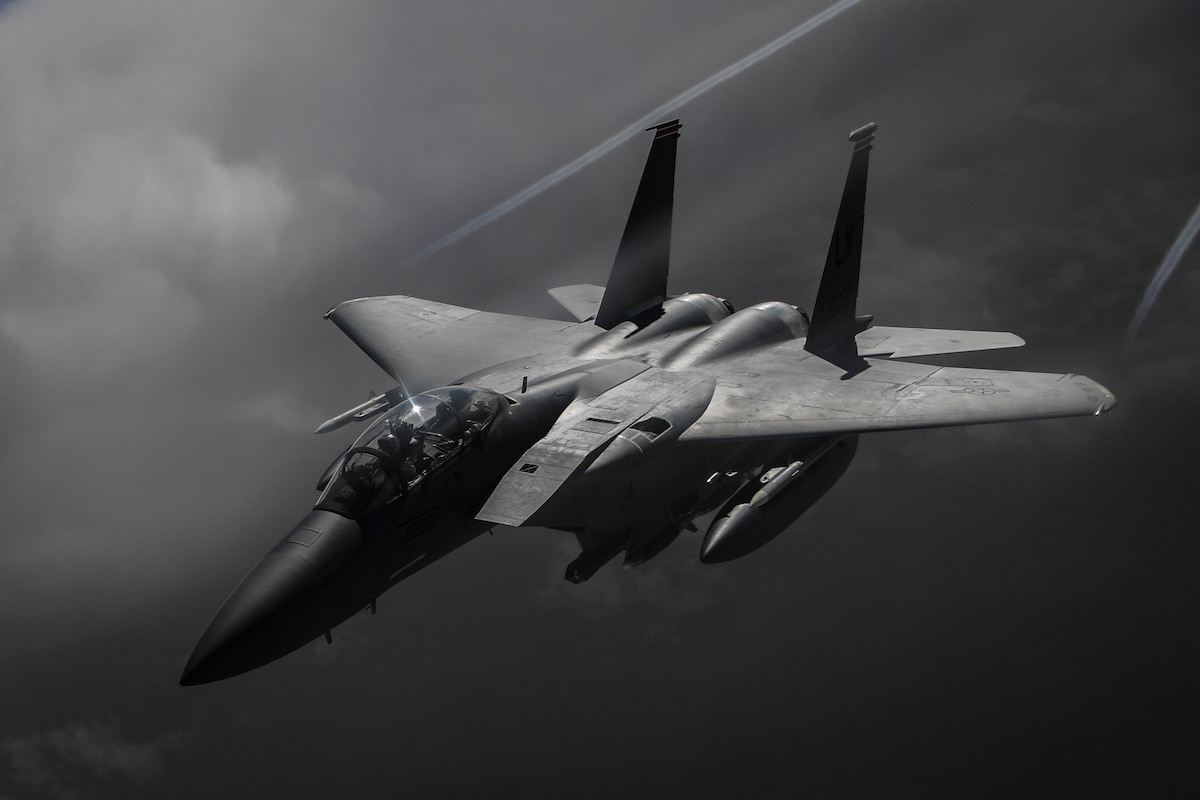The United States is adding more teeth to its aging F-15E and brand-new F-15EX fighter jets by equipping them with a crucial electronic warfare countermeasure system that will make them more effective against adversaries.
The US Air Force and defense manufacturer BAE Systems have finally completed testing the Eagle Passive Active Warning Survivability System, or EPAWSS. This technology will provide fighters with jamming and EW protection until their retirement.
Defense manufacturer BAE Systems announced that the USAF had finished the system’s initial operational and testing assessments, “validating the game-changing capabilities” of EPAWSS, as of April 2.
“EPAWSS was designed for upgradeability and rapid capability insertion,” said Amy Nesbitt, BAE Systems’ EPAWSS program manager. We’re using agile software development to provide iterative upgrades to fielded EW systems, allowing our customers to defeat future electromagnetic threats.”
The new EPAWSS system has full-spectrum electronic warfare capabilities, such as radar warning, geolocation, situational awareness, and self-defense. Additionally, the system permits greater mobility and infiltration into combat zones since it is shielded by contemporary integrated air defense systems.
This may be a major boost to the fighters, especially since they may have to face a well-shielded adversary like China in a near-peer conflict.
Major Bryant Baum, EPAWSS test director for the Air Force Operational Test & Evaluation Center, said, “EPAWSS is a leap in technology, improving the lethality and combat capabilities of the F-15E and F-15EX in contested, degraded environments against advanced threats.” According to Baum, EPAWSS “set the baseline” for electronic warfare among jet pilots. Over ten years have been spent developing it.
Documents related to the US Air Force fiscal 2025 budget indicate that the program’s procurement will end in 2029, following a $1.8 billion investment. Moreover, the Initial operational capability, or “Required Assets Available,” is now anticipated in around a year, according to Air Force Selected Acquisition Reports. The system will be provided to operational units over the next few months.
How Will EPAWSS Help F-15s?
The EPAWSS is an advanced electronic warfare suite that provides pilots an important capability to protect themselves and nearby assets even as it monitors, jams, and deceives enemy air defense and EW systems.
EPAWSS offers fully integrated radar warning, geolocation, situational awareness, and self-protection solutions to detect and defeat surface and airborne threats in the signal-dense and electronically contested environments of modern battlefields.
EPAWSS uses contemporary computing, receiver, and transmitter technology to provide pilots with better information so that they may act accordingly. Boeing says that the technology represents “a transformational overhaul to the F-15’s survivability.”
The F-15s that are not yet scheduled for retirement owing to structural fatigue and detectability by contemporary radars should be able to withstand far closer ranges than the F-15’s outdated electronic protection kit, the Tactical Electronic Warfare System.
A senior US Air Force official told Air and Space Forces Magazine that the EPAWSS “makes it possible to keep the F-15 in the fight for [several] years, instead of just doing Homeland Defense or [flying in] a low-threat environment.”

The first round of operational testing began in July 2023. The EPAWSS was tested in an operational environment in the Northern Edge 2023 exercise when the company claimed it successfully demonstrated “cognitive” electronic warfare while mounted on two new F-15EX Eagle II jets. July 2022 marked the start of the system’s low-rate first production.
“Cognitive” EW analyzes signals from threat radars and other transmitters using artificial intelligence or machine learning to determine the best method of jamming or tricking them.
The NE23 exercise assessed EPAWSS’s ability to respond promptly to previously unidentified electromagnetic threats. The company tested the system’s capacity to process in-flight sensor data, create complex algorithms, and adjust waveforms in real-time. Further, the NE23 environment posed a theater-exercise-level difficulty for the system to accomplish its objectives in a chaotic and densely populated electromagnetic spectrum.
US Air Force F-15E Strike Eagles assigned to 391st Fighter Squadron arrive on Marine Corps Air Station Iwakuni, Japan in preparation for Northern Edge 2023-2, June 29.https://t.co/Bz4ztEvZ7r pic.twitter.com/EfN11V0cGR
— Ryan Chan 陳家翹 (@ryankakiuchan) June 30, 2023
The F-15E was created in the 1980s to conduct long-range, high-speed interdiction missions without the aid of escorting or electronic warfare aircraft. However, battlefield realities have now changed with countries quickly employing anti-access/Area Denial systems using electronic warfare systems.
The addition of the EPAWSS would bolster their combat capability in the modern battlefield, especially since they are expected to fly for at least a few more years.
This is significant because, unlike fifth-generation aircraft such as the F-22 Raptors and F-35 Lightning IIs, which have stealth technologies that dramatically lower their radar signatures, the F-15E fighters are much more susceptible to an attack.
The old and new F-15s are crucial in a possible confrontation with China. Even though the F-35 is stealthy and has sophisticated airborne networking needed for advanced combat, the F-15 is quick, has a long range, and has a larger payload capacity than the F-35.
The Eagle’s superior thrust and superb maneuverability would be significant battlefield advantages in case of a contingency. Some military experts have gone on to say that these jets could outmaneuver the PLAAF stealthy J-20 Mighty Dragons.
The US Air Force is requesting $824 million in funding for fiscal year 2025 to complete the purchase and installation of EPAWSS on 99 F-15E Strike Eagles that the Air Force intends to keep.
The service is purchasing 94 new F-15EXs to replace the 100 F-15Es that will be retired in the next few years. The documents did not specify the number of aircraft that will be outfitted with EPAWSS annually.
The system is a crucial part of an effort to ensure the Strike Eagle’s continued viability at least until 2040.
- Contact the author at sakshi.tiwari9555 (at) gmail.com
- Follow EurAsian Times on Google News